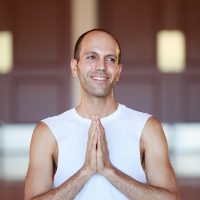Since I opened Yoga One in Petaluma CA, I have occasionally been asked if we ever offer any “hot yoga”. Though, as my dear friend Lisa Murray, who owns Yoga Community in Sonoma, likes to say, “nobody’s yoga is better than anybody else’s yoga”, we definitely do not and will not offer yoga classes in a hot room. Here’s why.
Multiple studies have examined the effects of elevated temperatures during exercise on performance, safety and recovery. Jentjens et al. demonstrated that the body uses more muscle glycogen and fewer ingested carbohydrates during exercise in a heated environment compared to a cooler environment. Midttun and Sejrsen (2002) have shown that dehydration, caused by increased respiration due to greater cooling needs while exercising in a hot environment, decreases blood and plasma volume, muscle strength and capacity, and liver glycogen. Moreover, as more blood is shunted to peripheral tissues to aid in cooling, less oxygenated blood is available for muscle tissues, the lungs, heart and other internal organs and tissues.
Multiple studies (Kabbara and Westerblad, Kaminski and Richmonds, Lamb, 2002) have demonstrated that the release and uptake of calcium, which is important in muscle contraction, is compromised by heat. McCully et al. (as well as Kabbara and Westerblad) have also shown that reduced blood circulation due to higher temperatures increases the rate of inorganic phosphate in the bloodstream and changes the composition of metabolites, interrupting calcium release and uptake and compromising normal muscle function.
I have spoken to many health and fitness professionals who share the concern. Cindy Tuck, owner and personal trainer at Main Street Fitness in Penngrove CA, has commented that when some of her clients suddenly started losing strength and actually regressing on their previous muscle gains, it turned out that the change corresponded to the clients starting to attend heated yoga classes.
I am even more concerned about the health and safety of connective tissue than I am about muscle function. “Practicing yoga in a hot room makes people feel like they are more flexible than they are, and they end up overstretching their tendons and ligaments,” says physical therapist Mitchell Kauk, Director of Petaluma Orthoapaedic and Sports Therapy. “The physiological effects of dehydration caused by heat leaves tendons and ligaments more vulnerable to injury.”
Since, as Tenforde has shown, the Rate of Perceived Exertion (RPE) is higher in a heated environment, it can feel like you get a hell of a workout (ok, pun intended) from heated yoga; but especially if instructors tell you to push the limits of your flexibility, as certain styles prescribe, you can leave the hot studio feeling like a million bucks every day for years, and one day hurt your spine or joints without ever knowing that it happened because you stretched the hell out of the connective tissue that was supposed to keep you together. Despite the low liability therefore involved in teaching heated yoga, I am categorically unwilling to compromise the long-term safety of my students just because they like it.
Warming up is good, but it doesn’t take heating the room to 104. I like my yoga room at around 70 Fahrenheit, and when I ask my students after a couple of simple breath and flow sequences whether anybody is cold, I regularly get laughs.
Tony Briggs, a 30-year veteran yoga teacher, owner of Turtle Island Yoga in San Anselmo CA and a faculty member at Yoga One Petaluma, shared a story with me about a visit that Patthabi Jois paid to an Ashtanga studio in the United States: “When he walked into the yoga studio, Patthabi said: ‘why is it so hot in here?’… We have these ideas in our minds of what the masters believe and have taught, but heating the room just isn’t it.”
In “The Effects of Cooling Core Body Temperature on Overall Strength Gains and Post Exercise Recovery” (Stanford University, 2003), Tenforde shows that “lowering core body temperature results in lower overall relative oxygen consumption during prolonged exercise,” arguing that “temperature is a limiting factor of exercise”.
“Professional bike riders are known to regularly cool themselves with ice applied during workouts,” explains Dr. Joel Erickson, a cardiologist with Santa Rosa Cardiology Medical Group and an avid amateur cyclist. “Formal research into the potential muscle-building effects of core body cooling during exercise is currently being conducted.”
Warming up is good, but so is cooling down. Ayurveda, yoga’s sister science of Indian medicine, has known for millennia that cooling areas such as the hands, ears and eyes releases pitta, “fire”, from the body; or, as modern science would word it:
The body core releases excess heat through areas consisting of arteriovenous anastomoses (AVA’s) and the subcutaneous venous plexuses found on hairless regions of the body consisting of the hands, feet, face and ears. These specialized vessels constrict and dilate as a response to higher and lower core temperatures, respectively. The result is a change in the venous temperature of the blood returning to the heart, impacting the core temperature. [Tenforde, 2003, citing studies by Bergersen et al., Grahn et al., Hales et al., Midttun and Sejrsen and Soreide et al.]
So, not only do we at Yoga One not teach heated yoga, we offer our students moist towelettes with a drop of cooling essential oil to use on their hands and face, after and even during class. We serve water with slices of cucumber or melon. And even the hot tea we offer is cooling in nature – mint, lemon verbena, chamomile.
Ayurveda’s motto applies here as it does virtually everywhere: “To Whom and When”. What is right for one person is not right for another, or even for the same person at another time. Nobody’s yoga is better than anybody else’s. But I will not teach yoga in a hot room, and I urge people to educate themselves about the science and to make informed decisions.
And we’re okay with not being hot. We’re just happy to be pretty damn cool.










Read 57 comments and reply